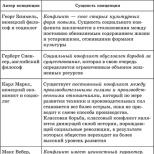Pituitrin mechanism of action. Pharmacological group - Choleretic agents and bile preparations. Side effects and drug actions
Pituitrin (Pituitrinum)
Pharmacological action of the drug.
Main active ingredients pituitrin are oxytocin and vasopressin (pitressin). The first causes a contraction of the muscles of the uterus, the second - a narrowing of the capillaries (the smallest vessels) and an increase blood pressure, participates in the regulation of the constancy of the osmotic pressure of the blood (hydrostatic pressure), causing an increase in the reabsorption of water (reabsorption) in the convoluted canal kidneys and a decrease in the reabsorption of chlorides.
What is used for. Indications for the use of the drug.
It is used to excite and enhance the contractile activity of the uterus during its primary and secondary weakness and distortion of pregnancy; hypotonic bleeding (bleeding caused by a decrease in the tone of the muscles of the uterus) in the early postpartum period; to normalize the involution of the uterus (reduction of the volume of the body of the uterus) in the postpartum and post-abortion periods. Diabetes insipidus (a disease caused by the absence or decrease in the secretion of antidiuretic / reducing urination / hormone). Bed-wetting.
Dosage and method of application.
The drug is administered under the skin or intramuscularly at 0.2-0.25 ml (1.0-1.25 IU) every 15-30 minutes 4-6 times. To enhance the effect, you can combine pituitrin with intramuscular injection estrogens (female sex hormones).
A single dose of pituitrin 0.5-1.0 ml (2.5-5 IU) can be used in the second stage of labor in the absence of obstacles to the advancement of the fetal head and rapid delivery.
To prevent and stop hypotonic bleeding in the early postpartum period, pituitrin is sometimes administered intravenously (1 ml - 5 IU - in 500 ml of 5% glucose solution) or very slowly (0.5-1 ml in 40 ml of 40% glucose solution).
In connection with the antidiuretic (reducing urination) effect of the drug, it is also used for bedwetting and diabetes insipidus. Injected under the skin and into the muscles of adults 1 ml (5 units), children under 1 year - 0.1-0.15 ml, 2-5 years - 0.2-0.4 ml, 6-12 years - 0.4-0.6 ml 1-2 times a day.
Higher doses for adults: single - 10 IU, daily - 20 IU.
Side effects and actions of the drug.
Large doses of pituitrin, especially with rapid administration, can cause spasms (a sharp narrowing of the lumen) of cerebral vessels, circulatory disorders, and collapse (a sharp drop in blood pressure).
Contraindications and negative properties.
Severe atherosclerosis myocarditis (inflammation of the heart muscle), hypertonic disease(persistent rise in blood pressure), thrombophlebitis (inflammation of the vein wall with their blockage), sepsis (infection of the blood with microbes from the focus purulent inflammation), nephropathy (kidney disease) of pregnant women. The drug can not be prescribed in the presence of scars on the uterus, the threat of uterine rupture, the wrong position of the fetus.
Release form. Package.
In 1 ml ampoules containing 5 units.
Terms and conditions of storage.
List B. In a place protected from light at a temperature of +1 to +10 ° C.
Composition and content.
A hormonal preparation derived from the posterior pituitary gland of cattle and pigs.
Transparent colorless liquid of acid reaction (pH 3.0 - 4.0).
Preserved with 0.25 - 0.3% phenol solution.
The main active ingredients of pituitrin are oxytocin and vasopressin (pitressin).
Pituitrin activity is standardized by biological methods; 1 ml of the drug should contain 5 units.
Active ingredients: Oxytocin, vasopressin
Important!
Description of the drug Pituitrin» on this page is a simplified and expanded version official instructions by application. Before purchasing or using the drug, you should consult your doctor and read the annotation approved by the manufacturer.
Information about the drug is provided for informational purposes only and should not be used as a guide to self-medication. Only a doctor can decide on the appointment of the drug, as well as determine the dose and methods of its use.
Made from whey foal mares. This drug has a follicle-stimulating effect. Indicated in estrogen deficiency. Promotes male spermatogenesis.
At appointment to men use large doses of serum hopadotropin, 1500 units 2-3 times a week N. 12 N. 16. The injections are repeated.
Women at hypogonadism prescribe injections during the follicular phase, 300-400 units for 14-15 days, followed by the introduction of chorionic hopadotropin for 7 days, 1000 units every other day.
Serum hoiadotropin effective in anovulatory infertility. Contraindications are the same as with chorionic gonadotropin.
Prolactin(Prolactinum). LTH preparation of the anterior pituitary gland. Promotes the secretion of milk in the postpartum period. Recommended for pregnant women with low lactation.
Recipe:
Rp. Prolactini 5.0
D.t. d. N. 6 in ampul.
S. 1 ml 2 times a day intramuscularly
Pituitrin P(Pituitrinum P). received as aqueous extract from the posterior pituitary gland of slaughtered cattle. Contains hormonal fractions of pazopressip, antidiuretic hormone and oxytocin. Vasopressure reduces vascular smooth muscle, increases the permeability of the main membranes of the renal tubules, helping to increase the concentration function of the kidneys. Raises blood pressure. It has an antidiuretic effect. Vasopressure also contributes to the contraction of the walls of the gallbladder and enhances intestinal motility.
Oxytocin provides contraction of the muscles of the uterus at the time of the onset of childbirth and in the postpartum period, ensuring its compression and release from the placenta.
Oxytocin has an effect on the contraction of muscle, fibers of the alveoli of the mammary glands, enhances the peristalsis of the tubes,
Pituitrin P It is used for diabetes insipidus and bedwetting, with intestinal atony and Bladder. It is prescribed for weak labor activity. But in these cases, with uterine atony, it is better to use the uterine fraction, pituitrin M, purified from vasopressor and antidiuretic effects.
Recipe:
Rp. Pituitrini P 1.0
D.t. d. N. 10 ampoule,
S. Under the skin, 1 ml 2 times a day
Children under 10 years of age suffering from diabetes insipidus or bedwetting, reduce the dose to 0.5 ml.
Complications: headaches, swelling, vomiting, nausea. As an extremely rare complication, " pituitary" with a drop in pulse and blood pressure is noted.
Contraindication to the use of pituitrin is pregnancy, miscarriage or premature birth. Nephropathy with edema, glomerulosclerosis. Hypertonic disease. Sclerosis of cerebral vessels.
Pituitrin M(Pituitrium M). This drug, purified from the antidiuretic and vasopressor fraction, selectively acts on the muscles of the uterus. It enhances labor activity. It is indicated for postpartum hemorrhage, with uterine atony.
Contraindication is the narrow pelvis of the woman in labor; malposition; scars on the uterus after caesarean section.
For faster action during childbirth, it can be administered intravenously with a 5% glucose solution. The content in 1 ml is 5 units per 1000 ml of glucose.
Recipe:
Rp. Pituitrini M 1.0 (5 units)
D.t. d. N. 6 in ampul. S. Under the skin, 1 ml 1-2 times a day
Pituitrin (Pituitrinum;) is a hormonal drug. Obtained from the posterior pituitary gland of slaughter cattle by water extraction. Contains two hormones - oxytocin (see) and. Pituitrin is used to enhance uterine contractions during childbirth, postpartum bleeding under the skin and intramuscularly, 0.2-0.25 ml (1-1.25 units) every 30 minutes. up to a total dose of 1 ml. It is also used for bedwetting and diabetes insipidus, in these cases, adults are administered 1 ml (5-10 IU). Contraindications:, nephropathy of pregnant women.
Release form: 1 ml ampoules (5 and 10 IU).
Pituitrin M is also produced, which is maximally freed from vasopressin. It is used to enhance uterine contractions during childbirth and postpartum hemorrhage. It is administered intravenously by drip method in a 5% glucose solution (5 IU in 1 liter of solution). Release form: 1 ml ampoules (5 units).
Pituitrin (Pituitrinum; synonym: Nurophysin, Pituglandol, Pituigan; list B) is a hormonal preparation containing oxytocin and vasopressin, an aqueous extract of the posterior pituitary gland of slaughter cattle.
The biological activity of pituitrin is determined by the content of oxytocin (see), which has the ability to cause contraction of the isolated horn of the uterus of the guinea pig, and is expressed in units of action (ED). Has antidiuretic action. It is indicated for weak labor activity of the uterus, postpartum hemorrhage, metrorrhagia, diabetes insipidus, bedwetting. Contraindicated in severe atherosclerosis, myocarditis, hypertension, nephropathy in pregnancy.
Adults are prescribed subcutaneously and intramuscularly for 5-10 units, children under 1 year old - 0.5 units, up to 5 years - 1-2 units, up to 12 years - 2-3 units 1-2 times a day. Higher doses: adults - single 10 IU, daily 20 IU; children from 6 months. up to 1 year - single 0.75 IU, daily 1.5 IU; 2 years - single 1.25 IU, daily 2.5 IU; 3-4 years - single 1.5 IU, daily 3 IU; 5-6 years - single 2 units, daily 5 units; 7-9 years - single 3 units, daily 7.5 units; 10-14 years - single 5 IU, daily 10 IU. To enhance labor activity, 2.5 units are administered every 15-30 minutes. up to a total dose of 10 IU. Release form: 1 ml ampoules containing 5 and 10 IU. Store in a cool, dark place. Dry pituitrin - see Adiurekrin. See also Hormonal preparations.
Pituitrin P. (Pituitrinum P. Extractum partis posterioris glandulae pituitariae) - an aqueous extract of the posterior pituitary gland, prepared from the pituitary glands of slaughter cattle. It differs from pituitrins A and T, containing, respectively, an extract of the anterior lobe of the gland (partis anterioris) and the entire gland (totalis). Transparent colorless liquid of acid reaction (pH 3.0-4.0). Preserved with 3% phenol solution. Contains hormonal substances of the posterior pituitary gland: octapeptides - oxytocin (causing contraction of the muscles of the uterus), vasopressin (causing narrowing of capillaries and an increase in arterial blood pressure) and antidiuretic hormone (participates in the regulation of the constancy of the osmotic pressure of the blood, causes an increase in water reabsorption in the convoluted tubules of the kidneys and reduces chloride reabsorption).
The biological activity of pituitrin P is determined by the property to cause contraction of the isolated uterus of a guinea pig and is expressed in units of action (ED). 1 ml of pituitrin P contains 5 or 10 units.
Indications. Atony of the uterus during childbirth. Postpartum bleeding. Menorrhagia. Metrorrhagia. Weakened activity of the heart. Paresis of the intestine. Diabetes insipidus. Bed-wetting.
Method of administration. Inject pituitrin P under the skin or intramuscularly for adults, 1 ml (5-Sh units). Children are administered preparations containing 5 IU per 1 ml: up to 1 year, 0.1-0.15 ml; 2-5 years, 0.2-0.4 ml; 6-12 years, 0.4-0.6 ml 1-2 times a day.
In obstetric practice, pituitrin II is administered in divided doses of 0.25 ml every 15-30 minutes to a total dose of 1 ml. A single dose of 0.5-1.0 ml can be used only when there are conditions for applying obstetric forceps.
In diabetes insipidus, the drug is used only when it is impossible to use adiurecrine. Since the effect of one injection does not exceed 4-5 hours, it is necessary to inject the drug 3-4 times a day.
Higher doses for adults: single 10 IU, daily 20 IU. For children under the age of 6 months, these doses are 0.5 and 1 U, respectively; from 0.5 to 1 year 0.75 and 1.5 units; from 1 year to 2 years 1.25 and 2.5 units; from 3 to 4 years - 2 and 5 units; at 7-9 years old 3 and 7.5 units; 10-14 years 5 and 10 units.
Contraindications. Nephritis. Uremia. Myocarditis. Hypertension. Nephropathy of pregnancy. Severe atherosclerosis.
Release form. Ampoules of 1 ml.
Store with caution in a cool, dark place.
Belongs to list B.
Shelf life 1 year.
Rp. Pituitrini P 1.0 (10 U).
D.t. d. N. 6 in ampuli.
S. 0.5-1 ml subcutaneously once a day for an adult.
| Pituitrinum
Analogues (generics, synonyms)
Gipofen, Hypophysin, Glanduithrin, Hyfototsin, Python, Pituglandol, Pituigan


Recipe (international)
Rp. Pituitrini 1 ml (5 ED)
D.t. d. N. 5 in ampul.
S. According to the scheme.
Recipe (Russia)
Prescription form - 107-1 / y
pharmachologic effect
The main active ingredients of pituitrin are oxytocin and vasopressin (pitressin). The first causes contraction of the muscles of the uterus, the second - narrowing of the capillaries (the smallest vessels) and an increase in blood pressure, participates in the regulation of the constancy of the osmotic pressure of the blood (hydrostatic pressure), causing an increase in water reabsorption (reabsorption) in the convoluted canal kidneys and a decrease in the reabsorption of chlorides.
Mode of application
For adults: Pituitrin is administered subcutaneously and intramuscularly at 0.2-1.0 ml; if necessary, the drug is administered intravenously in drops of 1 ml in 500 ml of 5% glucose solution or very slowly injected 1.0 ml of Pituitrin in 40.0 ml of 40.0% glucose solution.
In obstetric practice, Pituitrin is administered 0.25 ml repeatedly, every 15-30 minutes, up to a total dose of 1.0 ml.
With nocturnal urinary incontinence and diabetes insipidus administered intramuscularly and subcutaneously: adults - 1.0 ml;
Highest dose Pituitrin subcutaneously: single - 10 IU, daily - 20 IU.
For children: For children, the drug is prescribed according to age: up to 1 year - 0.10-0.15 ml, 2-5 years - 0.2-0.4 ml; 6-12 years - 0.4-0.6 ml 1-2 times a day of the drug containing 1.0 ml of 5 IU.
Indications
Pituitrin is used to excite and enhance uterine contractions (with weak labor, post-term pregnancy, postpartum, hypotonic bleeding, menometrorrhagia) and to normalize uterine involution.
- Indicated for atony and intestinal paresis, diabetes insipidus and bedwetting.
Contraindications
Severe atherosclerosis, angina pectoris, myocarditis, hypertension, hypertension and nephropathy in pregnant women, thrombophlebitis, sepsis, nephropathy in pregnant women; the presence of scars and the threat of uterine rupture, the wrong position of the fetus.
- In case of nephropathy of pregnant women, it is recommended to use pahikarpin or spherophysin to stimulate labor activity
Side effects
Spasm of cerebral vessels, collapse, hemodynamic disturbance.
Release form
A hormonal preparation derived from the posterior pituitary gland of cattle and pigs.
Transparent colorless liquid of acid reaction (pH 3.0 - 4.0).
Preserved with 0.25 - 0.3% phenol solution.
The main active ingredients of pituitrin are oxytocin and vasopressin (pitressin).
Pituitrin activity is standardized by biological methods; 1 ml of the drug should contain 5 units.
ATTENTION!
The information on the page you are viewing was created for informational purposes only and does not promote self-treatment in any way. The resource is intended to familiarize healthcare professionals with additional information about certain medicines, thereby increasing their level of professionalism. The use of the drug "" without fail provides for a consultation with a specialist, as well as his recommendations on the method of application and dosage of the medicine you have chosen.
The main active ingredients of pituitrin are oxytocin and vasopressin (pitressin). The first causes contraction of the muscles of the uterus, the second - narrowing of the capillaries (the smallest vessels) and an increase in blood pressure, participates in the regulation of the constancy of the osmotic pressure of the blood (hydrostatic pressure), causing an increase in water reabsorption (reabsorption) in the convoluted canal kidneys and a decrease in the reabsorption of chlorides.
Indications for use
It is used to excite and enhance the contractile activity of the uterus during its primary and secondary weakness and distortion of pregnancy; hypotonic bleeding (bleeding caused by a decrease in the tone of the muscles of the uterus) in the early postpartum period; to normalize the involution of the uterus (reduction of the volume of the body of the uterus) in the postpartum and post-abortion periods. Diabetes insipidus (a disease caused by the absence or decrease in the secretion of antidiuretic / reducing urination / hormone). Bed-wetting.
Mode of application
The drug is administered under the skin or intramuscularly at 0.2-0.25 ml (1.0-1.25 IU) every 15-30 minutes 4-6 times. To enhance the effect, pituitrin can be combined with intramuscular injection of estrogens (female sex hormones).
A single dose of pituitrin 0.5-1.0 ml (2.5-5 IU) can be used in the second stage of labor in the absence of obstacles to the advancement of the fetal head and rapid delivery.
To prevent and stop hypotonic bleeding in the early postpartum period, pituitrin is sometimes administered intravenously (1 ml - 5 IU - in 500 ml of 5% glucose solution) or very slowly (0.5-1 ml in 40 ml of 40% glucose solution).
In connection with the antidiuretic (reducing urination) effect of the drug, it is also used for bedwetting and diabetes insipidus. Injected under the skin and into the muscles of adults, 1 ml (5 units), children under 1 year old - 0.1-0.15 ml, 2-5 years old - 0.2-0.4 ml, 6-12 years old - 0.4-0.6 ml 1-2 times a day.
Higher doses for adults: single - 10 IU, daily - 20 IU.
Side effects
Large doses of pituitrin, especially with rapid administration, can cause spasms (a sharp narrowing of the lumen) of cerebral vessels, circulatory disorders, and collapse (a sharp drop in blood pressure).
Contraindications
Severe atherosclerosis, myocarditis (inflammation of the heart muscle), hypertension (persistent rise in blood pressure), thrombophlebitis (inflammation of the vein wall with their blockage), sepsis (infection of the blood with microbes from the focus of purulent inflammation), nephropathy (kidney disease) of pregnant women. The drug can not be prescribed in the presence of scars on the uterus, the threat of uterine rupture, the wrong position of the fetus.
Release form
In 1 ml ampoules containing 5 units.
Storage conditions
List B. In a place protected from light at a temperature of +1 to +10 ° C.
Active substance
Modern medications: complete practical guide. Moscow, 2000. S. A. Kryzhanovsky, M. B. Vititnova.
WHO Collaborating Center for Methodology statistical studies drugs (The WHO Collaborating Center for Drug Statistics Methodology).
Composition
A hormonal preparation derived from the posterior pituitary gland of cattle and pigs.
Transparent colorless liquid of acid reaction (pH 3.0 - 4.0).
Preserved with 0.25 - 0.3% phenol solution.
The main active ingredients of pituitrin are oxytocin and vasopressin (pitressin).
Pituitrin activity is standardized by biological methods; 1 ml of the drug should contain 5 units.
Description of the drug Pituitrin" on this page is a simplified and supplemented version of the official instructions for use. Before purchasing or using the drug, you should consult a doctor and read the annotation approved by the manufacturer. Information about the drug is provided for informational purposes only and should not be used as a guide to self-treatment. Only the doctor can decide on the prescription of the drug, as well as determine the doses and methods of its use.





